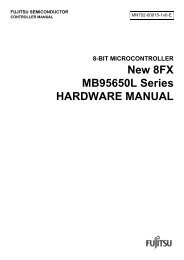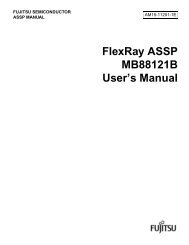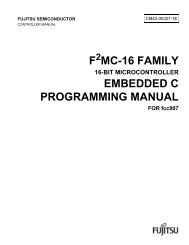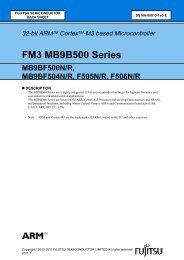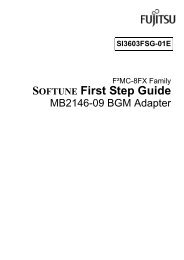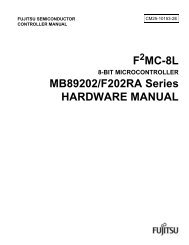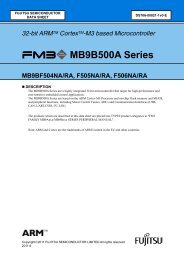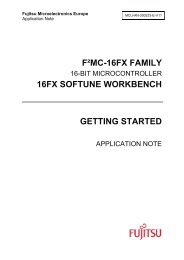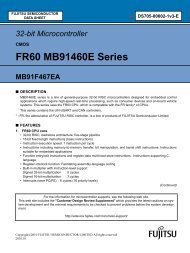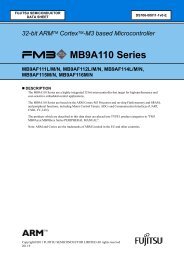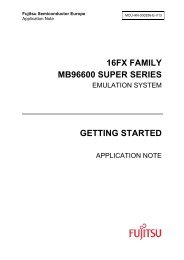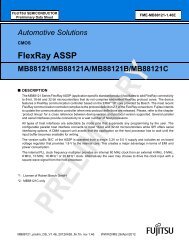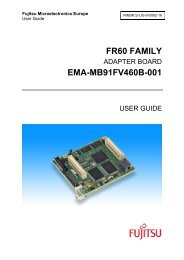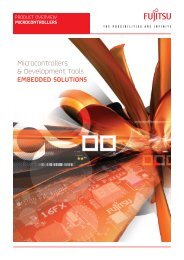J-Link / J-Trace User Guide (UM08001) - Microcontrollers
J-Link / J-Trace User Guide (UM08001) - Microcontrollers
J-Link / J-Trace User Guide (UM08001) - Microcontrollers
You also want an ePaper? Increase the reach of your titles
YUMPU automatically turns print PDFs into web optimized ePapers that Google loves.
126 CHAPTER 5 Working with J-<strong>Link</strong> and J-<strong>Trace</strong><br />
5.11.1.1 device<br />
This command selects the target device.<br />
Syntax<br />
device = <br />
DeviceID has to be a valid device identifier. For a list of all available device identifiers<br />
please refer to chapter Supported devices on page 139.<br />
Example<br />
device = AT91SAM7S256<br />
5.11.1.2 DisableFlashBPs<br />
This command disables the FlashBP feature.<br />
Syntax<br />
DisableFlashBPs<br />
5.11.1.3 DisableFlashDL<br />
This command disables the J-<strong>Link</strong> ARM FlashDL feature.<br />
Syntax<br />
DisableFlashDL<br />
5.11.1.4 EnableFlashBPs<br />
This command enables the FlashBP feature.<br />
Syntax<br />
EnableFlashBPs<br />
5.11.1.5 EnableFlashDL<br />
This command enables the J-<strong>Link</strong> ARM FlashDL feature.<br />
Syntax<br />
EnableFlashDL<br />
5.11.1.6 map exclude<br />
This command excludes a specified memory region from all memory accesses. All<br />
subsequent memory accesses to this memory region are ignored.<br />
Memory mapping<br />
Some devices do not allow access of the entire 4GB memory area. Ideally, the entire<br />
memory can be accessed; if a memory access fails, the CPU reports this by switching<br />
to abort mode. The CPU memory interface allows halting the CPU via a WAIT signal.<br />
On some devices, the WAIT signal stays active when accessing certain unused memory<br />
areas. This halts the CPU indefinitely (until RESET) and will therefore end the<br />
debug session. This is exactly what happens when accessing critical memory areas.<br />
Critical memory areas should not be present in a device; they are typically a hardware<br />
design problem. Nevertheless, critical memory areas exist on some devices.<br />
To avoid stalling the debug session, a critical memory area can be excluded from<br />
access: J-<strong>Link</strong> will not try to read or write to critical memory areas and instead<br />
ignore the access silently. Some debuggers (such as IAR C-SPY) can try to access<br />
memory in such areas by dereferencing non-initialized pointers even if the debugged<br />
program (the debuggee) is working perfectly. In situations like this, defining critical<br />
memory areas is a good solution.<br />
J-<strong>Link</strong> / J-<strong>Trace</strong> (<strong>UM08001</strong>) © 2004-2010 SEGGER Microcontroller GmbH & Co. KG



